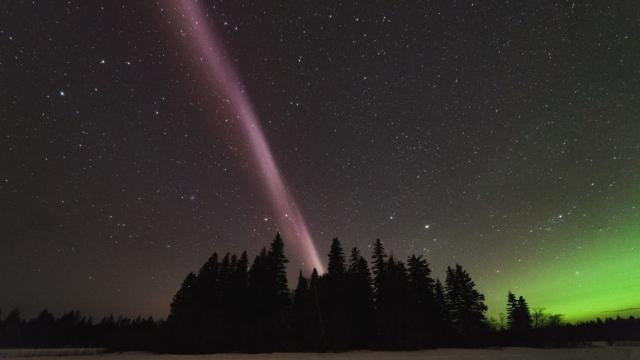New research into a strange atmospheric effect known as STEVE has failed to associate its enigmatic lights with aurora, pointing to the presence of an entirely new type of atmospheric phenomenon.
Scientists started to look into these strange lights just a few years ago after people began to post images to a Facebook group called the Alberta Aurora Chasers. These lights have the outward appearance of conventional auroras, but instead of vast sheets blanketing the night sky, these lights are narrow in scope, appearing as colourful ribbons.
The phenomenon was given a silly name, STEVE, or Strong Thermal Emission Velocity Enhancement, but the presence of these lights is now the subject of serious scientific scrutiny.
The latest research, published this week in Geophysical Research Letters, shows that STEVE, as an atmospheric process, is distinct from auroras. Unsatisfied with the placeholder name, the researchers, led by Bea Gallardo-Lacourt from the University of Calgary, have proposed the term “skyglow” to describe the previously undocumented phenomenon.
Auroras happen when electrons and protons from our planet’s magnetosphere rain down onto the ionosphere — a region of charged particles in the upper atmosphere. When protons and electrons are excited, they emit a range of colours, typically green, red and blue.
STEVEs bear a striking resemblance to auroras, but with some important differences. As noted, they look like narrow ribbons in the night sky, featuring vibrant purple and white hues. They seem to run from east to west, and they’re located closer to the equator than typical auroras.
Also, auroras are visible on practically every night in regions where they’re normally seen, but the thin light ribbons from STEVE are only seen a few times each year.
[referenced url=”https://gizmodo.com.au/2018/03/citizen-scientists-discover-new-feature-of-the-aurora-borealis/” thumb=”https://i.kinja-img.com/gawker-media/image/upload/t_ku-large/ddqcqkwove5d3vyn7sqw.jpg” title=”Citizen Scientists Discover New Feature Of The Aurora Borealis” excerpt=”It wasn’t scientists who discovered the thin, purple, east-to-west travelling glow in the northern night sky. It was people with cameras and a nerdy passion for auroras.”]
Despite these differences, scientists understandably thought that STEVEs were produced by the same processes that result in auroras, namely particle precipitation onto the ionosphere.
Earlier this year, Gallardo-Lacourt linked a phenomenon known as subauroral ion drift (SAID) to STEVEs, hypothesising that strong westward ion flows might have something to do with it. This research suggested that fast-moving ions and super-hot electrons are passing through the atmosphere where STEVEs are observed. It was an important association, but the ultimate cause of STEVE remained unknown.
On 28 March 2018, Gallardo-Lacourt’s team had an opportunity to analyse a STEVE event. It was an excellent opportunity to see if the light from STEVEs are produced by particles raining down onto the ionosphere (like auroras), or by some other process.
This STEVE event was analysed using a network of ground-based All-Sky Images located across Canada, and with energetic particle detectors onboard NOAA’s Polar Orbiting Environmental Satellite 17 (POES-17), which happened to pass directly over the ground-based cameras during the STEVE event (this satellite can measure charged particles raining onto the ionosphere).
Analysis of the data showed that STEVEs aren’t actually aurora. The POES-17 satellite detected no traces of particle precipitation, which means STEVEs are “clearly distinct” from aurora, in the words of the researchers. The light from STEVEs are likely generated by “a new and fundamentally different mechanism in the ionosphere,” write the researchers.
“Our main conclusion is that STEVE is not an aurora,” said Gallardo-Lacourt in a statement. “So right now, we know very little about it. And that’s the cool thing, because this has been known by photographers for decades. But for the scientists, it’s completely unknown.”
Looking ahead, the researchers would like to determine if the streams of fast ions and hot electrons in the ionosphere are responsible for producing STEVE’s light, or if the light is produced higher up in the atmosphere.
It’s a very humbling problem, and yet another example of how much there’s still to learn about our planet.
